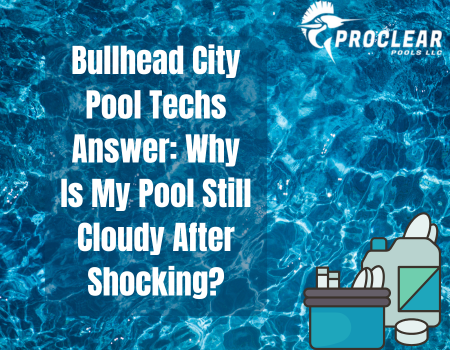 If you live in Bullhead City, you know how important it is to have a clear, sparkling pool to beat the desert heat. But few things frustrate pool owners more than spending time and money on a shock treatment—only to find the water still cloudy the next day.
If you live in Bullhead City, you know how important it is to have a clear, sparkling pool to beat the desert heat. But few things frustrate pool owners more than spending time and money on a shock treatment—only to find the water still cloudy the next day.
Shocking is one of the most common ways to restore pool clarity and kill bacteria, but it’s not always a magic fix. Local pool techs often hear the same question: “Why is my pool still cloudy after shocking?” The answer usually comes down to a mix of water chemistry, filtration, and maintenance habits.
Here are the most common reasons your pool stays cloudy after shocking—and what to do about them.
1. Poor Filtration and Circulation
Even if your chemicals are perfectly balanced, your pool won’t clear up without a strong, functioning filter system.
Why it happens:
- Filters clogged with dirt, sand, or oils can’t trap fine particles.
- Pumps running too few hours per day fail to circulate the water properly.
- Old or worn filter media (like sand or cartridges) lose effectiveness over time.
What Bullhead City techs recommend:
- Run your pump continuously for at least 24 hours after shocking.
- Backwash sand and DE filters, or rinse cartridge filters thoroughly.
- Replace filter media every 3–5 years depending on the type.
2. Unbalanced Pool Chemistry
Shocking only works well when your water chemistry is in the right range. Cloudiness often means something else in the balance is off.
Key culprits include:
- High pH: Chlorine loses much of its sanitizing power when the pH level rises above 7.8.
- High total alkalinity: Causes calcium to precipitate, leaving the water hazy.
- High calcium hardness: Common in Bullhead City’s hard water supply, leading to scaling and cloudiness.
What to do: Test your water before and after shocking. Keep your pool’s pH between 7.2 and 7.6, and maintain alkalinity in the 80–120 ppm range. If calcium hardness is too high, partial draining and refilling may be needed.
3. Dead Algae in the Water
If you shocked your pool after an algae outbreak, the shock likely killed the algae—but it didn’t remove it. Dead algae particles are tiny and can leave your water looking cloudy or greenish.
How to fix it:
- Brush the walls and floor thoroughly to loosen algae residue.
- Vacuum the pool to remove the debris.
- Run the filter 24–48 hours and clean it regularly during this process.
4. Insufficient Shock Dosage
Sometimes, cloudy water lingers simply because not enough shock was used. Pool size, algae growth, and contaminant load all determine how much chlorine you need.
What to consider:
- One bag of shock isn’t always enough, especially in larger Bullhead City pools.
- Heavy rain, wind, and high swimmer loads (all common in summer) demand higher doses.
Tip: Calculate your pool volume and follow product guidelines carefully. It’s better to slightly over-shock than under-shock when battling stubborn cloudiness.
5. Environmental Factors Unique to Bullhead City
Living in the desert means your pool faces challenges many other regions don’t.
Local factors include:
- Dust storms: Fine desert dust slips past filters and lingers in water.
- High heat and sunlight: Intense UV rays burn off chlorine quickly, reducing effectiveness.
- Hard water: Makes chemical balancing more difficult and promotes cloudy buildup.
Solutions: Use a pool cover during dust storms, add cyanuric acid (stabilizer) to protect chlorine from UV rays, and stay on top of water testing during peak summer months.
6. Inadequate Brushing and Cleaning
Even with balanced chemistry, water won’t clear if particles remain stuck to surfaces.
What to do weekly during monsoon and summer seasons:
- Brush walls, steps, and ladders.
- Vacuum the floor after storms or heavy use.
- Empty skimmer and pump baskets to maintain strong circulation.
7. Not Giving It Enough Time
Lastly, patience matters. After shocking, it can take 24–48 hours for water to clear—sometimes longer if your pool was in bad shape. Running the pump and cleaning filters consistently during this period is key.
When to Call a Bullhead City Pool Pro
If you’ve tried everything—balancing chemistry, cleaning filters, vacuuming, and running the pump—and your pool still won’t clear, it may be time to call a local pool technician. Cloudy water can sometimes signal deeper issues like failing equipment, hidden leaks, or chemical imbalances that need professional testing.
Cloudy pool water after shocking is a common issue for Bullhead City homeowners, but it’s rarely unsolvable. In most cases, the cause comes down to poor filtration, unbalanced chemistry, dead algae, or environmental factors like dust and hard water.
By staying on top of weekly maintenance, running your equipment properly, and testing your water often, you can prevent cloudy water from becoming a recurring headache. And when in doubt, local pool pros are ready to help you enjoy the crystal-clear pool you deserve in the Arizona heat.
